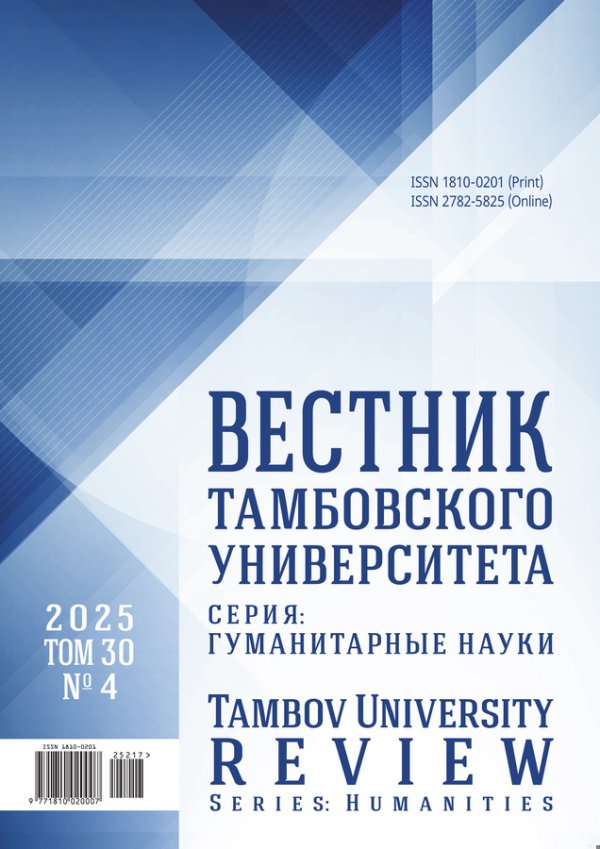Спиралевидная процессуальность в обучении будущих лингвистов грамматике французского языка
- Авторы: Брыксина И.Е.1, Сидорова А.А.1
-
Учреждения:
- ФГБОУ ВО «Тамбовский государственный университет им. Г.Р. Державина»
- Выпуск: Том 29, № 2 (2024)
- Страницы: 438-451
- Раздел: ТЕОРИЯ И МЕТОДИКА ОБУЧЕНИЯ ИНОСТРАННОМУ ЯЗЫКУ
- URL: https://ogarev-online.ru/1810-0201/article/view/297864
- DOI: https://doi.org/10.20310/1810-0201-2024-29-2-438-451
- ID: 297864
Цитировать
Полный текст
Аннотация
Актуальность. Рассмотрен методический потенциал спиралевидной процессуальности в обучении будущих лингвистов грамматике французского языка. Данная личностно-ориентированная технология используется для развития у обучающихся умений применять полученные знания по иностранному языку для решения профессиональных проблем, способствует интеграции и структурированию полученных знаний, обеспечивает переход учебной деятельности в профессиональную. Проанализировано теоретическое описание метода спирали, обосновано ее значение для обучения студентов грамматике и ее корректное использование в процессе письменной и устной коммуникации. Целью данного исследования выступает изучение теоретических основ построения спиралевидной процессуальности, ее применения в обучении французской грамматике будущих лингвистов, а также доказательство ее продуктивности в формировании и совершенствовании грамматической компетенции на уроках французского языка.Материалы и методы. Использовались следующие пособия: «Французский язык» М.С. Левина, О.Б. Самсонова, В.В. Хараузова и “À l’heureactuelle” Lucia Bonato. Применялся теоретический анализ научно-методической литературы, передового методического опыта; опытное обучение; наблюдение; анкетирование; описания; элементы количественных подсчетов.Результаты исследования. Для создания дидактической спирали предложены следующие компоненты: основная идея или цель изучения материала, вторичные (и последующие) идеи, связи между компонентами, иллюстративный материал, цветовой раздражитель, другие, соответствующие тематике курса. Определен алгоритм работы со спиралевидной процессуальностью, включающий в себя четыре этапа: информационно-подготовительный (организация работы с изучаемой темой), технологический (участие студентов в обсуждении, анализе и сравнении изученных грамматических форм), концептуализирующий (составление ментальных карт и выполнение упражнений), оценочный (тестирование и корректировка ошибок). Были определены следующие устные и письменные задания: дискуссия, тестирование, грамматические упражнения. Целесообразность использования спиралевидной процессуальности в обучении грамматике французского языка находит свое подтверждение в проведенном авторами эксперименте, статистические расчеты и анкетирование обучаемых доказали результативность предложенной технологии.Выводы. Доказана эффективность использования спиралевидной процессуальности в обучении грамматике французского языка будущих лингвистов. Данная методика обеспечивает интеграцию материала и плавный переход от учебной деятельности в профессиональную на каждом этапе дидактической спирали. Распределение материала от простого к более сложному помогает обучающемуся организованно и упорядоченно усваивать его. Составление и использование ментальных карт совершенствует и тренирует долговременную память, оказывает положительное влияние на усвоение и корректное воспроизведение грамматических конструкций. Интеллект-карты предоставляют возможность наглядно расположить материал на «поверхности», что позволяет легче воспринимать и визуализировать его. Обеспечивается формирование профессиональной компетенции по завершении работы со спиралью, а именно – развитие грамматической компетенции, навыков общения и осознанности как на уровне намеренности (мотивация), так и на уровне контроля (участие в дискуссии).
Об авторах
И. Е. Брыксина
ФГБОУ ВО «Тамбовский государственный университет им. Г.Р. Державина»
Email: bryxina68@mail.ru
ORCID iD: 0000-0002-5866-733X
кандидат педагогических наук, доцент, доцент кафедры лингвистики и лингводидактики
392000, Российская Федерация, г. Тамбов, ул. Интернациональная, 33А. А. Сидорова
ФГБОУ ВО «Тамбовский государственный университет им. Г.Р. Державина»
Автор, ответственный за переписку.
Email: asidorova0911@gmail.com
ORCID iD: 0009-0005-8217-9239
научный сотрудник лаборатории языкового поликультурного образования
392000, Российская Федерация, г. Тамбов, ул. Интернациональная, 33Список литературы
- Harden R.M., Davis M.H., Crosby J.R. The new Dundee medical curriculum: a whole that is greater than the sum of the parts // Medical Education. 1997. Vol. 31. Issue 4. P. 264-271. https://doi.org/10.1111/j.1365-2923.1997.tb02923.x
- Lohani V.K., Mallikarjunan K., Wolfe M.L. et al. Work in progress – spiral curriculum approach to reformulate engineering curriculum // Proceedings Frontiers in Education 35th Annual Conference. Indianopolis: Institute of Electrical and Electronics Engineers, 2005. Art. F1D-1. https://doi.org/10.1109/FIE.2005.1612007
- Howard J. Curriculum Development. Elon: Elon University: Center for the Advancement of Teaching and Learning, 2007. Summer. P. 1-7. URL: https://www.uwindsor.ca/ctl/sites/uwindsor.ca.ctl/files/curriculum-development.pdf (accessed: 20.01.2024).
- Бегунц А.В., Соловьева О.С. О применении и дидактической спирали при построении учебных программ // Вестник Московского университета. Серия 20: Педагогическое образование. 2021. № 4. C. 15-36. https://doi.org/10.55959/MSU2073-2635-20-2021-4-15-36, https://elibrary.ru/jhzajs
- Ставцева И.В., Колегова И.А. Спиралевидная процессуальность в организации занятий по методике преподавания иностранных языков студентов лингвистического направления // Педагогика. Вопросы теории и практики. 2021. Т. 6. № 2. С. 331-338. https://doi.org/10.30853/ped210028, https://elibrary.ru/mhvsgg
- Щепилова А.В. Когнитивный принцип в обучении второму иностранному языку: к вопросу о теоретическом обосновании // Иностранные языки в школе. 2003. №2. С. 4-11. https://elibrary.ru/vijwyf
- Дмитренко Т.А. Личностно-ориентированные технологии обучения в системе высшего языкового образования в условиях его цифровизации // Наука и школа. 2021. № 6. C. 173-183. https://doi.org/10.31862/1819-463X-2021-6-173-183, https://elibrary.ru/diqxbv
- Брыксина И.Е., Деркач А.К., Глущенко О.А. Использование ментальных карт на иностранном языке в формировании профессиональной лексической компетенции студентов медицинского вуза // Язык и культура. 2023. № 64. С. 103-122. https://doi.org/10.17223/19996195/64/6, https://elibrary.ru/vxnpib
- Campillo-Ferrer J.M., Miralles-Martínez P. Effectiveness of the flipped classroom model on students’ selfreported motivation and learning during the COVID-19 pandemic // Humanities and Social Sciences Communications. 2021. Vol. 8. Issue 1. Art. 176. https://doi.org/10.1057/s41599-021-00860-4
- Брыксина И.Е., Сидорова А.А. Технологии реализации стандартов высшего образования путем использования тандем-метода // Преподаватель высшей школы: традиции, проблемы, перспективы: материалы 12 Всерос. науч.-практ. Internet-конф. (с междунар. участием) / отв. ред. Л.Н. Макарова. Тамбов: Изд. дом «Державинский», 2021. С. 107-113. https://elibrary.ru/vhhhsd
- Кузнецова Ю.В. Применение интерактивных методов обучения иностранному языку в вузе // Мир науки, культуры, образования. 2022. № 1 (92). С. 94-96. https://doi.org/10.24412/1991-5497-2022-192-94-96, https://elibrary.ru/zqproe
- Брыксина И.Е., Сидорова А.А.Применение интерактивных методов обучения иноязычной лексике в языковом вузе // Преподаватель высшей школы: традиции, проблемы, перспективы: материалы 13 Всерос. науч.-практ. Internet-конф. (с междунар. участием) / отв. ред. Л.Н. Макарова. Тамбов: Изд. дом «Державинский», 2022. С. 97-102. https://elibrary.ru/ahljms
- Сысоев П.В., Хмаренко Н.И. Обучение студентов иноязычной письменной речи на основе педагогической технологии обучения в сотрудничестве // Язык и культура. 2022. № 59. С. 271-285. https://doi.org/10.17223/19996195/59/15, https://elibrary.ru/zbcbib
- Титова С.В., Баринова К.В. Способы предоставления обратной связи и организации рефлексии в онлайн-обучении иностранным языкам // Вестник Московского университета. Серия 19: Лингвистика и межкультурная коммуникация. 2021. № 2. С. 200-214. https://elibrary.ru/dscein
Дополнительные файлы










